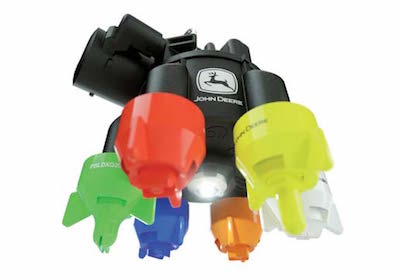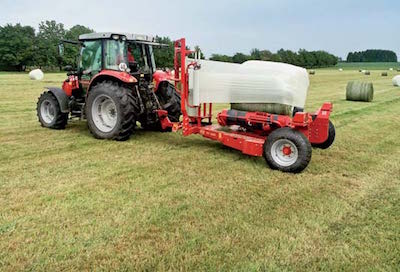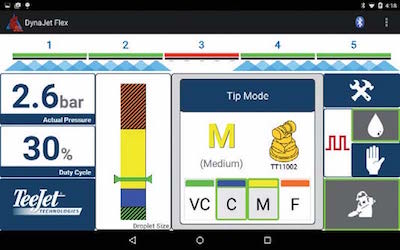Along with their Gold Medal and Silver Medal award presentations, SIMA 2017, the Paris International Agribusiness Show that will be held Feb. 26 – Mar. 2, also announced several “Special Mention” awards as part of the Innovation Award program to farm equipment manufacturers who introduced new innovations in the past year. Part 3 of the awards is presented here.
The award winners were selected by a panel of 25 experts from France, and headed up by Jean-Marc Bournigal, chairman of the French National Research Institute of Science and Technology for Environment and Agriculture.
Special Mention: John Deere ExactApply Intelligent Nozzle Body
For spraying equipment, speed, pressure and flow are traditionally related, forcing operators to work within limited ranges. With the Pulse Width Modulation (PWM) principle, You can have optimal spray quality without matching pressure to flow rate. With the PWM system, the pump maintains constant pressure (chosen by the operator) and the flow rate is controlled by the nozzle bodies. Flow, speed, and pressure can be adjusted independently.
The nozzle bodies control the flow rate by creating micro-cuts (beats). Ultra-rapid cutoffs (up to 30 times per second) and the alternating function of the nozzle bodies provide spraying with consistent droplet size and no skips. The John Deere ExactApply system uses this technology to provide unprecedented ranges of application. Operators can work at constant pressure on a 1-3 speed/flow rate range: from 10-30 kph at constant dose or from 100-300 L/ha at constant speed.
Conversely, pressure can be lowered (parcel exterior) or raised (parcel interior) to limit the risk of peripheral drift. By individually controlling each nozzle head, the automatic cutoff by GPS is now done by each nozzle head (2-4% less coverage), and in a curve (up to 25% discrepancy), the system adjusts the flow-rate of each nozzle head to maintain a constant dose across the entire width. The nozzle body consists of two solenoids with a pulse capacity of 15Hz each, and a rotating cylinder. This exclusive design provides the option of working in combined mode (frequency of up to 30 Hz) or independent mode: each solenoid controls a different nozzle head, to spray according to circumstances and automatically with one, the other or both nozzle heads.
Special Mention: Kverneland Group’s ‘Auto Feed Control’ Automatic Feed System for Round Balers
Round balers are sensitive to chamber feed regularity. It’s not easy to obtain a perfectly cylindrical bale, and it requires a certain practice: the driver has to make sure that the volume of material that comes in at the center, left and right of the chamber is close to equal to get a well-formed bale.
Conventional variable chamber balers require “navigating” the windrow from left to right to balance out the load. To make users’ lives easier, chamber loading devices came into being and over time have become more modern, boosted by the development of on-vehicle electronics. But the need to change position on the windrow persists and it is a stressor for the driver.
On machines equipped with AFC (Auto Feed Control), the baler’s standard arrow is replaced with a special rod equipped with two telescoping arms that are moved hydraulically. The independent elongation of the left and right jacks changes the shape of the rod so the baler can be shifted from one side or the other. The baler’s offset position makes it possible to feed the pickup from one side or the other, with no need to move the tractor off the windrow.
Information from the load sensors is reused by the on-vehicle electronics to continuously adjust the baler’s position at the rear of the tractor. The system all together makes it possible to offset the baler left or right even as the tractor holds its position compared to the perfectly centered, stable windrow. For greater precision, the arrow is equipped with angular sensors so that you know the exact position of the baler compared to the tractor at all times. The user no longer has to drive on the windrow, which prevents flattening and pollution of the windrow by earth.
Special Mention: New Holland’s High Efficiency Cooling System
As things stand, the cooling pack takes up a lot of space at the front of the engine compartment. In addition, the periodic cleaning of radiators involves a complicated process to guarantee access to each of the layers. While a traditional cooling pack can include more than 5 types of coolers in front of the fan, the high efficiency cooling system (HEHRS) has only 2: one to cool the engine and another for the low temperature loop.
With HEHRS, the cooling pack’s footprint can be reduced and efficiency improved because the fan uses less power. Plate coolers replace traditional air/air or air/liquid radiators. They are attached to a new low temperature liquid cooling circuit (about 50 degrees C). This low temperature loop locally cools the tractor’s different components (air conditioning condenser, transmission fluid, intake air after compression by the turbo). It distributes cooling requirements while making each cooler more compact.
An electric pump supplies these different circuits with cooling liquid. Controlled valves paired with outlet temperature sensors modulate the rate of cooling liquid according to requirements. A pilot algorithm controls the flow rate of the electric pump and the opening of each of the valves. If needed, it also acts on the fan’s system to increase its speed.
In addition, the individual control of each portion of the low temperature circuit reduces the time during which the fan is on at full power. Together with a variable pitch fan, a 4% gain in consumption can be measured, thanks to this new design.
Special Mention: Sencrop Real-Time Farming Weather Platform
Sencrop is designed for farmers and offers them a real-time application linked to farming weather stations and sensors located in their fields to help them improve organization and decide when to take action on a daily basis using accurate, ultra-local data. This farming weather service can be connected to decision aiding tools (DAT). This approach overcomes differences encountered when using weather forecast services based on a small number of sensors which, as a result, do not provide suitable information for the condition of the area observed.
In particular, the Sencrop application can upload farming weather data in real-time 24 hours a day, analyze reliable data (automatic detection of deviation and customer validation in the event of marked differences from well known laboratories) to improve agronomic models and make the most of advice given to farmers, track operating conditions in fields, create simple alerts (accumulated rainfall, low volume, etc.) and do so such a way that information can be shared, improves decision making about what action to take: spraying, irrigation, sowing, etc., and supplies agronomic models with reliable, retrievable and ultra-local farming weather data. The idea is to be able to see field information at a glance, share it and also target spraying advice and help direct farm work for local conditions.
Easy to use: a single button on the sensor to switch it on and a very ergonomic graphic interface (mobile and PC). A highly autonomous “Plug-&-Play” solution. The farming weather stations, which can be transported if you want to change the field they are in during or at the end of the season, are connected via low speed, long range networks.
Special Mention: SMAG/Smart Agriculture Application for the Internet of Things for Agriculture (IoTA)
Faced with the growing number of connected objects on the farm and their associated applications (weather stations, traps, camera, tracker, flow meter, hive, etc.), SMAG has created the first mobile application for centralized management of all objects present on the farm.
This innovative application, which is unique on the agricultural market, offers 3 functions: geolocalization of all of the objects, consultation of their associated data (targeted weather, proliferation of pests, soil quality, etc.) and automatic recovery of field data from Agreo and Atland web solutions (surface area, type of crop, field name, etc.). Finally, combining these 2 sources of information generates intelligent alerts for each object to feed high performance decision aiding tools. Ultimately, thanks to IoTA, farmers will be able to take the right decision at the right time and reduce risks in their fields. This project was developed in partnership with the companies CAP2020 and WEENAT and marks the launch of a unique ecosystem in IoT in farming.
Special Mention: Kverneland Group ‘High Speed Pack’ Turntable Binding System
Even though satellite wrappers provide greater task throughput, sales of turntable wrappers are higher than other methods of securing hay bales because they are easy to use and cost effective.
The stability of a bale on a turntable wrapper is related to rotation speed. Centrifugal force can eject the bale from the wrapper. Two things can exacerbate this: first, the bale’s irregular shape (a bale with poor left/right distribution of material), and second, the shape of the ground (working on steep slopes or moving over obstacles like humps). A bundle that’s ejected can hurtle down a slope and cause serious damage (especially if it crosses a road).
To avoid these problems, the user manually adjusts the table’s turning speed, which is very often set quite a bit lower than optimal speed, by reducing the tractor’s hydraulic throughput. The patented Optispeed device (automatic baler turntable speed adjustment system), combined with the dual-extender DuoWrap system, solves this issue of safety and task speed optimization for turntable wrappers. The dual arm for pre-stretching supports two film spools, reducing the number of turns of the bale for the same number of layers.
The accelerometer measures the machine’s oscillations and the electronics automatically regulates hydraulic throughput to maximize wrapping while keeping the bale from being ejected on slopes or with unbalanced bales. The table’s optimal turning speed is constantly calculated, adjusted, and obtained by the on-vehicle electronics, not left to the driver’s discretion. In optimal working conditions (well-formed bales and flat field), the table’s turning speed is increased from 15-25%.
Special Mention: TeeJet Technologies’ DynaJet Flex 7140 — Flow Variation System Without Pressure Variation
In the systems currently available on the market, known as DPAE (flow rate proportional to the advance), spraying pressure is linked to the speed of advance. When the speed increases, the pressure in the nozzle increases much more quickly (the pressure varies with the square of the flow rate), very fine droplets form and a risk of drift arises, particularly in windy conditions.
When this happens, spraying quality becomes very poor as the droplets become too small and tend not to adhere to the target; reducing speed will have equally negative effects due to an increase in droplet size and a reduction in the impact rate per cm. The DynaJet Flex 7140 system provides strict control of droplet size thanks to Pulse Width Modulation (PWM) technology that dissociates spraying pressure and the nozzle flow rate, and dissociates the operating pressure, droplet size and application dose. This system can be installed on any sprayer with a flow rate controller, regardless of the type of regulator and on new or retrofitted equipment.
E-ChemSaver. electric solenoids are installed on each nozzle body in the place of the anti-drip mechanisms. The solenoids operate at a constant frequency of 20 hertz. The system automatically adjusts the duty cycle to maintain a constant pressure and therefore a constant droplet size matching the size programmed in the cabin by the operator. The pressure at the nozzle outlet is constant, the droplet size is regular and the quality of spraying, fully controlled.
In addition, the DynaJet controller incorporates a nozzle database for which all of the droplet size characteristics are correlated to information on the various possible operating pressures.
Special Mention: WeFarmUp.COM Agricultural Machinery Sharing Platform
WeFarmUp.com invents mutual aid version 3.0 by creating “digital cooperation” between farmers, as well as between CUMA, ETA and dealers. Some manufacturers also use the platform to simplify the logistics of farm equipment demonstrations. By “connecting” the sheds of operating farms, WeFarmUp.com makes the equipment available “visible” to each farmer locally (less than an hour by tractor) at a given time. And in this way, eFarmUp.com offers a new type of access to farming machinery.
This application is entirely compatible with pre-existing solutions (dealer, traditional mutual aid, CUMA, EDT, etc.). The contribution it makes is that hiring (payment per use rather than full ownership) provides the economic flexibility necessary in the new and extremely volatile economic context of the post 2010 years.
WeFarmUp.com restores cash resources and competitiveness to farms suffering from over-equipping by “unlocking” funds “locked up” in farmers’ sheds, by offering a solution to young farmers in the form of the option of gradual investment, and to all farmers looking for a way to finally make their investments in equipment cost effective.
All this, ultimately, to restore competitiveness in the face of international competition (U.S., Ukraine, etc.) where farms are much larger. WeFarmUp.com is the first farmer-to-farmer equipment sharing platform in the world and it has become the world leader. Since WeFarmUp was created in October 2015, other entirely comparable initiatives have sprung up in various countries (including the U.S., Denmark, Egypt and India), demonstrating that France has been a pioneer in this domain.
Due to its capacity for foresight, WeFarmUp.com remains the leader with already, at the end of October, a community of 2,900 WeFarmers and 1,850 items of equipment available for hire.





